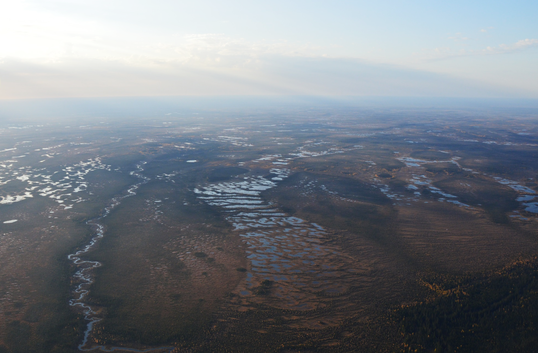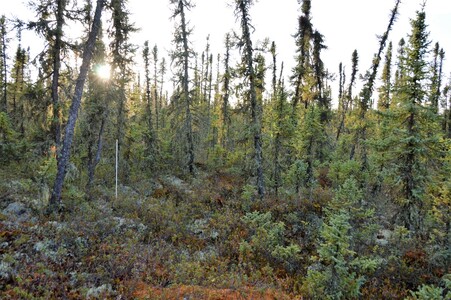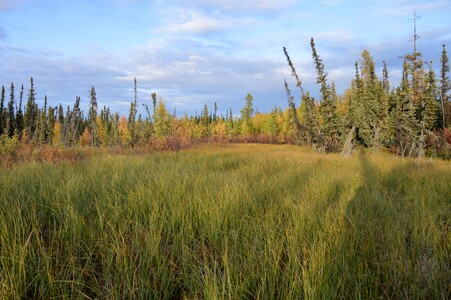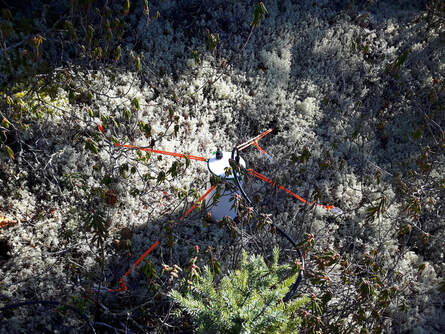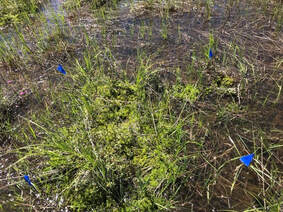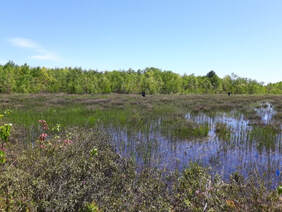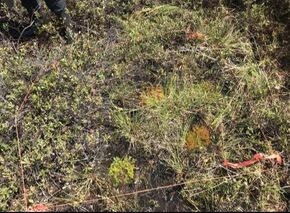Main Areas of Research
The Structure and Function of Boreal and Subarctic Ecosystems
|
Peatlands are important carbon stores but our knowledge of the hydrological and biogeochemical processes controlling carbon dynamics in these systems is limited. To understand the processes controlling carbon accumulation and loss in peatland systems, it is essential to understand how peatlands develop, and how the structure and function of these ecosystems are controlled by internal and external forces. I am especially interested in the feedback mechanisms controlling spatial heterogeneity within peatlands and carbon dynamics (including CO2 and CH4 fluxes). The microtopography of peatlands is visually distinct, particularly in the Hudson Bay Lowlands where typical hummock-hollow microforms occur along with parallel sequences of ridges and pools. |
Impacts of Environmental Change
The effects of climate change on northern peatlands remain uncertain. Increasing temperatures are predicted which will affect hydrological processes within peatlands as well as vegetation type and cover. These structural changes will in turn alter the biogeochemical processes within the peatland, which will likely alter the status of a bog, fen, or peat swamp as a carbon sink or source. These structural and biogeochemical changes will also occur due to development for resource extraction and associated infrastructure. In addition to the direct impacts from the construction and operational footprint, there are hydrological impacts caused by groundwater drawdown for subsurface excavation. My research questions relate to impacts on vegetation communities and changes in the spatial distribution of species as the hydrological characteristics of microforms shift with overall lower peatland water tables. I am also looking at how these ecosystem shifts impact gas exchange, both across different vegetation-microform types within peatlands, and across the peatland landscape.
The effects of climate change on northern peatlands remain uncertain. Increasing temperatures are predicted which will affect hydrological processes within peatlands as well as vegetation type and cover. These structural changes will in turn alter the biogeochemical processes within the peatland, which will likely alter the status of a bog, fen, or peat swamp as a carbon sink or source. These structural and biogeochemical changes will also occur due to development for resource extraction and associated infrastructure. In addition to the direct impacts from the construction and operational footprint, there are hydrological impacts caused by groundwater drawdown for subsurface excavation. My research questions relate to impacts on vegetation communities and changes in the spatial distribution of species as the hydrological characteristics of microforms shift with overall lower peatland water tables. I am also looking at how these ecosystem shifts impact gas exchange, both across different vegetation-microform types within peatlands, and across the peatland landscape.
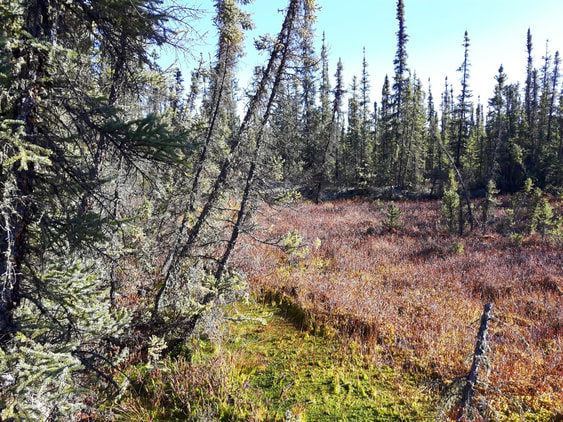 Thawing permafrost peatland plateau and thermokarst bog in northern Alberta
Thawing permafrost peatland plateau and thermokarst bog in northern Alberta
I use a wide range of techniques to answer my research questions, including closed chamber studies of greenhouse gas fluxes (CO2 and CH4), analysis of peat core properties, hydrological monitoring, and detailed vegetation surveys.
Some of my projects (with ongoing data collection and analysis) and papers in preparation include:
Ecohydrological controls on CH4 emissions from pristine and drained peatlands in the Hudson Bay Lowland (Harris, L.I., Roulet, N.T., and Moore, T.R.) - in prep
CO2 exchange in a boreal peatland 2-years post-fire (Harris, L.I., Wilkinson, S., and others) - in prep
|
Winter CO2 emissions from burned and unburned permafrost peatlands (Harris, L.I., Schulze, C., Heffernan, L., Olefeldt, D., and others) - in prep Quantifying the capacity of peatlands across Canada for the provision of ecosystem services (Harris, L.I., and others) - ongoing data synthesis and analysis - in prep |
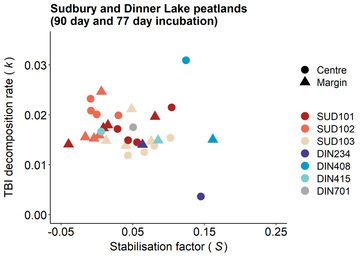 Preliminary results from an analysis of tea bags as a decomposition proxy, comparing heavy-metal damaged peatlands in the Sudbury area and undamaged reference peatlands further south
Preliminary results from an analysis of tea bags as a decomposition proxy, comparing heavy-metal damaged peatlands in the Sudbury area and undamaged reference peatlands further south
An imperfect brew: comparing decomposition rates in surface peat of metal-contaminated peatlands and undisturbed peatlands using the Tea Bag index (Harris, L.I., Seward, J., Smenderovac, E., Beckett, P., and others) - in prep
Impact of changing land-cover in thawing and burned permafrost peatlands on habitat suitability for moose and woodland caribou (Harris, L.I., Olefeldt, D., and others) - ongoing data analysis - in prep
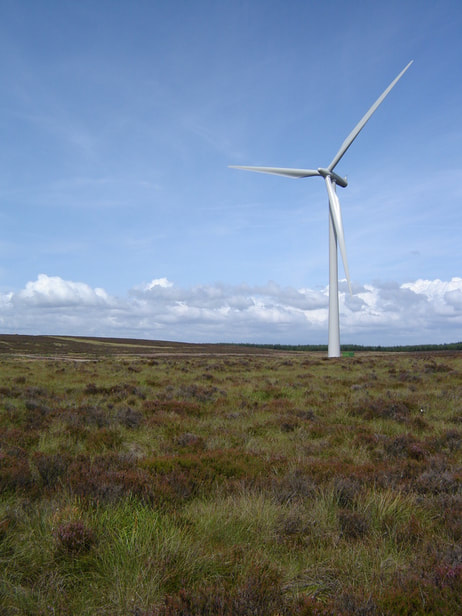 Wind farm development on peatland in south-west Scotland
Wind farm development on peatland in south-west Scotland
Wetland Restoration
Prior to starting my research in Canada, I worked for 6 years as a Wetland Ecologist for the Scottish Environment Protection Agency (SEPA). I reviewed many Environment Impact Assessments (EIA) for developments impacting wetlands, including renewable energy projects (mostly wind farms) and mining developments. As well as questions on how to determine, assess, and minimise damage to wetlands from proposed development, questions on how to successfully restore wetlands and to what purpose became prominent. Wetland restoration can be particularly difficult due to the complex hydrological requirements of different wetland types, such as groundwater dependent wetlands and rain/snow-fed bogs. Although wetland vegetation may be used as an indicator of successful restoration it is not certain if the function of the wetland has been restored, especially with regards to status as a carbon sink or source, and what timescale after restoration is required to determine this status.
Sustainability Science and Policy
I am a former member of the organising committee for the McGill Sustainability Research Symposium (Academic Lead for 2014 Edition, and Project Lead for the 2015 Edition). Understanding human interactions with ecosystems and how we can manage these interactions sustainably is becoming more important in the face of an increasing global population, demand for resources, and climate change. Although my research is focused primarily on wetland ecosystems, it is important to understand and engage in interdisciplinary research to tackle the range of sustainability issues. Effective communication of scientific research is also crucial for developing and improving policy for sustainable environmental management decisions.
Prior to starting my research in Canada, I worked for 6 years as a Wetland Ecologist for the Scottish Environment Protection Agency (SEPA). I reviewed many Environment Impact Assessments (EIA) for developments impacting wetlands, including renewable energy projects (mostly wind farms) and mining developments. As well as questions on how to determine, assess, and minimise damage to wetlands from proposed development, questions on how to successfully restore wetlands and to what purpose became prominent. Wetland restoration can be particularly difficult due to the complex hydrological requirements of different wetland types, such as groundwater dependent wetlands and rain/snow-fed bogs. Although wetland vegetation may be used as an indicator of successful restoration it is not certain if the function of the wetland has been restored, especially with regards to status as a carbon sink or source, and what timescale after restoration is required to determine this status.
Sustainability Science and Policy
I am a former member of the organising committee for the McGill Sustainability Research Symposium (Academic Lead for 2014 Edition, and Project Lead for the 2015 Edition). Understanding human interactions with ecosystems and how we can manage these interactions sustainably is becoming more important in the face of an increasing global population, demand for resources, and climate change. Although my research is focused primarily on wetland ecosystems, it is important to understand and engage in interdisciplinary research to tackle the range of sustainability issues. Effective communication of scientific research is also crucial for developing and improving policy for sustainable environmental management decisions.
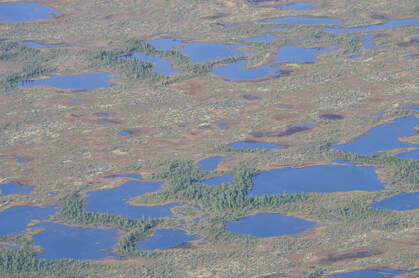
Northern Peatlands In Canada - An Enormous Carbon Storehouse
To learn more about peatlands across Canada, take a look at this Story Map developed by Wildlife Conservation Society Canada: https://t.co/hPvHNtEuUr?amp=1
